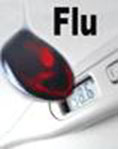
THURSDAY, Jan. 29, 2014 (HealthDay News) — After a rough start to the flu season, the number of infections seems to have peaked and is even starting to decline in many parts of the nation, federal health officials reported Thursday.
“We likely reached our highest level of activity and in many parts of the country we are starting to see flu activity decline,” said Dr. Michael Jhung, a medical officer in U.S. Centers for Disease Control and Prevention’s Influenza Division.
Jhung added, however, that flu remains widespread in much of the country.
As has been the case since the flu season began, the predominant type of flu continues to be an H3N2 strain, which is not a good match to this year’s vaccine. The majority of H3N2-related infections diagnosed so far — 65 percent — are “different from the strain in the vaccine,” he said.
The reason: the circulating H3N2 strain mutated after scientists settled last year on the makeup of this season’s flu shot.
This year’s flu season continues to hit children and the elderly hardest. And some children continue to die from flu. “That’s not surprising,” Jhung said, adding that 56 children have died from complications of flu.
In an average year, children’s deaths vary from as few as 30 to as many as 170 or more, CDC officials said.
Jhung thinks that over the next few weeks, as in other flu seasons, different flu strains — such as H1N1 — will likely become more common. “I expect to see some other strains circulating, but I don’t know how much,” he said.
That could be good news on the vaccine front. Right now, the flu vaccine is only about 23 percent effective, due to the mutated H3N2 strain. But, as other strains become more widespread, the vaccine’s effectiveness should increase, Jhung said.
Most years, flu vaccine effectiveness ranges from 10 percent to 60 percent, according to the CDC.
Twenty-three percent effectiveness means there’s some benefit — a little less flu among vaccinated people. Typically, flu is more common among the unvaccinated, but this year there’s been a lot of flu both in people who are vaccinated and in those who aren’t, CDC officials said.
Vaccine effectiveness is also related to the health of those getting the shot. Flu vaccine usually works best in young, healthy people, and is less effective in those 65 and older, the CDC said.
So far, this year’s shot has been most effective — 26 percent — for children 6 months old through 17 years. Older people have been getting less benefit — 12 percent effectiveness for those 18 to 49 years and 14 percent effectiveness for those 50 and older, according to the CDC.
Jhung said that all the data right now suggest that this flu season will be like the last H3N2 season — in 2012-13. “At the end of that season, we called it a ‘moderately severe’ season,” he said.
And even though it’s well into the flu season, Jhung said it’s not too late to get a flu shot. “It’s the first line of protection,” he said.
The CDC recommends that everyone 6 months and older get vaccinated. Vaccination can prevent some infections and reduce severe disease that can lead to hospitalization and death, the agency says.
Other ways to treat and prevent flu from spreading include early treatment with antiviral drugs such as Tamiflu and Relenza, and washing hands frequently and covering your mouth when coughing or sneezing.
As of the middle of January, all areas of the country reported flu activity at or above baseline levels. Twenty-three states and Puerto Rico experienced high activity. Ten states and New York City experienced moderate activity. Another 10 states reported low flu activity and seven states reported minimal activity, the CDC reported.
More information
For more on flu, visit the U.S. Centers for Disease Control and Prevention.
Copyright © 2025 HealthDay. All rights reserved.

